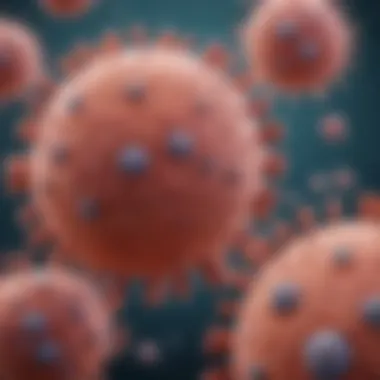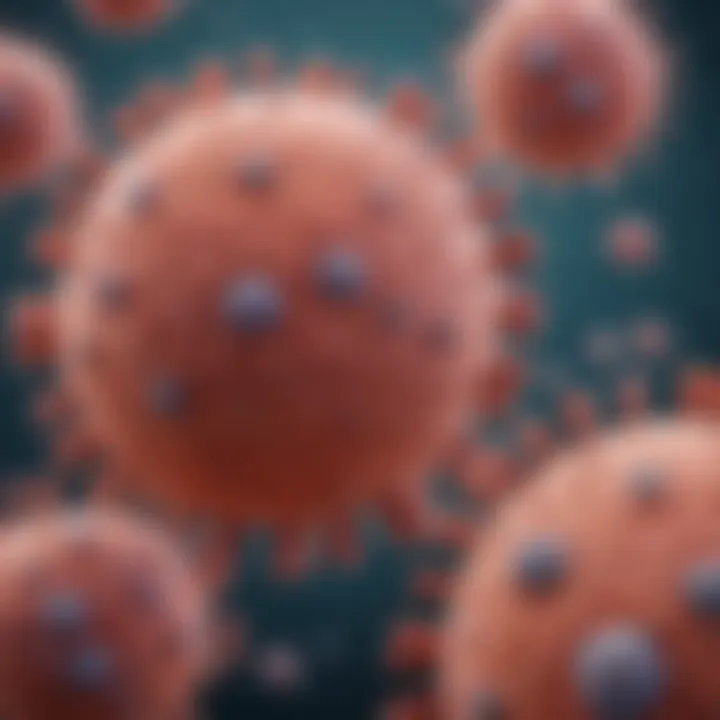Understanding Hepatocellular Cancer: Risks, Diagnosis, and Treatment


Intro
Hepatocellular cancer (HCC) represents a significant challenge within the field of oncology and public health. As the predominant type of liver cancer, HCC affects millions worldwide, often linked with chronic liver diseases such as cirrhosis and hepatitis. The complexity of its causative factors—spanning both environmental influences and genetic predispositions—makes understanding HCC essential for improving treatment strategies and patient outcomes.
This disease doesn’t emerge in a vacuum; it weaves itself into the larger tapestry of health issues related to the liver, calling for multi-faceted approaches to manage and combat it. Factors such as alcohol consumption, obesity, and exposure to aflatoxins are prevalent among the risk factors. These elements may not seem intertwined at first glance, yet they create a fertile ground for the development of HCC over time.
In this study, we aim to dissect the specification of HCC, providing a roadmap from etiology to prognosis. Every detail counts, whether examining the molecular mechanisms that trigger cancer cell growth or understanding the clinical presentations that signal its onset in patients.
This narrative seeks not only to educate but also to serve as a touchstone for future inquiry—because, as we all know, every bit of new knowledge feeds into a larger pond of understanding, benefiting both practitioners and explorers of medical science alike.
Prolusion to Hepatocellular Cancer
Hepatocellular cancer, often abbreviated as HCC, represents a critical area of study in the realm of oncology, primarily due to its status as the most prevalent type of liver cancer. In the global health landscape, understanding HCC is essential not only for medical professionals but also for researchers exploring the intricate mechanisms underpinning this disease. As we delve deeper into hepatocellular cancer, it’s vital to appreciate how this form of cancer interlaces with various risk factors and biological responses, painting a complex picture that requires a multidimensional approach to effectively address the challenges it poses.
The significance of this discourse is underscored by several pivotal elements:
- Increasing Incidence: Cases of HCC are on the rise globally, warranting a thorough examination of its epidemiology and impact on different populations.
- Diverse Etiologies: The underlying causes range from viral infections to lifestyle choices, indicating a pressing need for personalized preventive measures.
- Clinical Implications: HCC presents unique challenges in diagnosis and treatment, emphasizing the importance of understanding its clinical presentation and progression.
As we navigate through the complexities of hepatocellular cancer, it is not merely about listing facts but about grasping the nuances of a disease that affects millions worldwide. The exploration will cover everything from foundational definitions to current trends in research and treatment options, providing the reader with a comprehensive guide that can enhance both academic discourse and clinical practice.
Etiology of Hepatocellular Cancer
Understanding the etiology of hepatocellular cancer (HCC) is paramount, as it plays a crucial role in both prevention and treatment strategies. The causes of HCC are multifaceted, encompassing a range of risk factors and genetic influences. Delving into these elements helps elucidate how lifestyle choices, underlying health conditions, and environmental exposures interact, potentially leading to liver cancer. Moreover, recognizing these factors can empower individuals and healthcare practitioners to adopt preventive measures that could mitigate the risk.
Risk Factors
Viral Hepatitis Infection
Viral hepatitis infection has a significant foothold in the landscape of liver cancer causes. Hepatitis B and C viruses (HBV and HCV) stand out as the primary culprits, responsible for a substantial percentage of HCC cases globally. The key feature of these infections lies not only in their infectious nature but also in their chronicity, which can lead to long-term liver damage and cirrhosis.
Chronic liver inflammation associated with HBV and HCV can set the stage for malignant transformations in liver cells. In this article, exploring these viruses is vital. They demonstrate a clear connection with HCC, offering insights into preventative strategies such as vaccination and screening.
"Chronic viral infections remain one of the leading causes of hepatocellular carcinoma worldwide, underscoring the importance of public health interventions."
Alcohol Consumption
Alcohol consumption is another well-documented risk factor for HCC. The relationship between heavy drinking and liver cancer is complex, as it not only contributes to liver damage but also enhances the risk of cirrhosis, a precursor to cancer. Alcohol can induce oxidative stress and inflammation, both of which are pivotal in the carcinogenic process.
Here, we consider not just the quantity of alcohol consumed but also the context—chronic consumption over years versus sporadic binge drinking. This nuance is essential to understand how alcohol affects liver health and raises concerns over liver cancer. Additionally, it poses challenges in public health messaging about moderate versus excessive drinking.
Metabolic Disorders
Metabolic disorders, such as non-alcoholic fatty liver disease (NAFLD), also play a significant role in the etiology of HCC. The global rise of obesity and metabolic syndrome has brought NAFLD into the spotlight. This condition is characterized by an accumulation of fat in the liver and can progress to inflammation, fibrosis, and ultimately cancer.
What makes metabolic disorders particularly interesting in this discussion is their interrelation with lifestyle factors—diet, exercise, and other health behaviors. They underline the importance of holistic health in the prevention of liver cancer. Early detection and management of metabolic conditions could be beneficial in mitigating HCC risk.
Genetic and Environmental Influences
Beyond lifestyle-related factors, genetic predispositions and environmental influences can increasingly shape individual HCC risk. Certain genetic mutations may affect how one's body processes liver toxins or manages inflammation, paving the way for cancer under specific conditions. Understanding these nuances is crucial for tailoring prevention strategies and therapeutic approaches effectively.
Taking a comprehensive view of both internal and external factors involved in HCC development elevates the discourse around prevention and treatment. By weaving together lifestyle factors, genetic predispositions, and environmental exposures, researchers can better outline pathways toward effective prevention and treatment strategies.
Pathophysiology of Hepatocellular Cancer
The pathophysiology of hepatocellular cancer (HCC) stands at the crossroads of a myriad of intricate biological processes and pathways that dictate the development and progression of this formidable disease. Understanding these complex mechanisms is paramount in our quest to better diagnose, treat, and ultimately prevent HCC. The exploration of pathophysiology encompasses two critical dimensions: the molecular mechanisms at play and the interplay with the tumor microenvironment.
Molecular Mechanisms
Mutations and Genetic Alterations
At the core of HCC's pathophysiology lies mutations and genetic alterations. These aberrations serve as foundational elements that disrupt normal cellular function, paving the way for carcinogenesis. One of the most striking aspects of mutations is their heterogeneity; different patients can exhibit a wide array of genetic changes.
A key characteristic of these mutations is their role in driving uncontrolled cell proliferation. For instance, mutations in the TP53 gene, which is crucial for regulating the cell cycle and maintaining genomic stability, are frequently observed in HCC patients. This particular alteration not only enhances the proliferative capacity of liver cells but also contributes to their ability to evade apoptotic signals, allowing for the survival of potentially malignant cells. The profound impact of these genetic alterations cannot be understated—they fundamentally change the landscape of liver cellular metabolism and signaling. These mutations offer significant insight into potential therapeutic targets, making it a popular choice for discussions in medical research regarding liver cancer.
However, as we delve deeper into the realm of genetic mutations, we uncover a nuanced duality. While certain mutations present opportunities for targeted therapies, such as those directed against the mutated BRAF or EGFR pathways, they also introduce challenges. The diversity of mutations can hinder the development of universal treatments and necessitate a more personalized approach to therapy, underscoring the complexity of HCC management.
Epigenetic Modifications
Alongside genetic changes, epigenetic modifications play a crucial role in the development of hepatocellular cancer. Unlike genetic mutations, these modifications do not alter the DNA sequence itself but instead influence gene expression through mechanisms such as methylation and histone modification. This characteristic of epigenetic changes offers a different perspective on cancer development, as they can be reversible, offering potential therapeutic avenues that genetic mutations do not.
One notable feature of epigenetic modifications is their ability to silence tumor suppressor genes or activate oncogenes through methylation of promoter regions. For example, hypermethylation of the CDKN2A gene, a significant tumor suppressor, is often detected in liver cancers. Recognizing these alterations not only helps in understanding the tumorigenesis of HCC but also highlights new biomarkers for early detection strategies, making it a high-interest area in ongoing research.
The benefits of focusing on epigenetic modifications extend to treatment as well. As researchers explore the use of demethylating agents, the prospect of reversing the malignant phenotype appears more plausible. Nevertheless, the risk remains that while we might successfully reactivate certain tumor suppressor genes, other unintended consequences might arise, leading to an unpredictable response.
Tumor Microenvironment


The tumor microenvironment, often overshadowed by genetic factors, is another integral aspect of the pathophysiology of hepatocellular cancer. This microenvironment is not just a backdrop but a dynamic entity that interacts intricately with tumor cells. It consists of a constellation of non-cancerous cells, including immune cells, fibroblasts, and endothelial cells, all of which contribute to the neoplastic process.
The contribution of the tumor microenvironment to HCC is multifaceted. It supports tumor growth by providing essential cytokines and growth factors. For instance, the presence of inflammatory cells often boosts angiogenesis, which is critical for supplying nutrients to rapidly dividing tumor cells. Moreover, the microenvironment can also confer resistance to therapies, as the immune landscape can inhibit the efficacy of immunotherapies.
In the broader picture, understanding the tumor microenvironment opens the doorway to innovative treatment strategies. Targeting the interactions between tumor cells and their microenvironment may yield synergistic effects, enhancing the overall outcome.
"Understanding HCC's pathophysiology not only unravels the intricate web of molecular and microenvironmental factors but also highlights the potential for innovative interventions that go beyond traditional therapies."
Overall, delving into the pathophysiology of hepatocellular cancer reveals a labyrinth of genetic and molecular changes that inform the disease's behavior. As research advances, these insights inspire hope for more effective diagnostic and treatment modalities, focused on ameliorating the burdens of this challenging disease.
Clinical Presentation
Clinical presentation is an essential facet of understanding hepatocellular cancer (HCC), serving as a window into how the disease manifests in patients. Recognizing clinical signs and symptoms not only aids in early detection but also informs treatment strategies. For healthcare providers, the insights drawn from early presentations can be pivotal in tailoring a patient’s care plan and potentially improving outcomes. Essentially, this section highlights the red flags that might prompt a patient to seek medical attention, guiding them through the labyrinth of symptoms associated with liver cancer.
Symptoms and Signs
Abdominal Pain
Abdominal pain often emerges as a primary symptom encountered by individuals grappling with HCC. It typically presents as a constant or intermittent discomfort, frequently localized in the upper right quadrant of the abdomen. This symptom is significant in the context of HCC because it hints at potential liver enlargement or metastasis, acting as a warning bell that shouldn't be overlooked. The key characteristic of this pain is its gradual onset, which can sometimes take months, making it easy to dismiss as a benign issue. However, its recognition is crucial, as it directs clinicians to undertake further evaluations, such as imaging studies. The downside of relying solely on this symptom is that it might not be present in all cases, leading to missed opportunities for early diagnosis.
Unexplained Weight Loss
Unexplained weight loss intrigues researchers and clinicians alike due to its connection with underlying malignancies, including HCC. Patients might notice a significant drop in weight without any change in their diet or exercise habits, which can be alarming. This symptom often signifies a more systemic issue related to the body’s metabolic functions, which can be disrupted by cancer growth. A notable feature of unexplained weight loss is its psychological impact—patients experiencing this can become anxious or fearful, often jumping to conclusions about their health. It is undeniably a valuable marker in the diagnostic journey; however, it must be interpreted in conjunction with other symptoms to avoid misdiagnosis. Moreover, this symptom could sometimes mislead one toward assuming a benign cause when, in fact, it may point to a more serious condition.
Jaundice
Jaundice is a defining clinical presentation for liver ailments, including HCC. Characterized by the yellowing of the skin and eyes, jaundice results from the accumulation of bilirubin in the bloodstream when the liver's function is impaired. This symptom serves as a pivotal marker, alerting both patients and healthcare practitioners that something is amiss with the liver's ability to process waste. Interestingly, jaundice tends to be one of the more visually pronounced symptoms that can prompt urgent medical evaluation, thus playing a critical role in the early diagnosis of hepatocellular cancer. While not every HCC patient will develop jaundice, its presence usually indicates advanced disease; thus, prompt intervention is necessary to manage associated complications. However, it should be noted that the presence of jaundice, while grave, does not confirm the presence of HCC without supportive diagnostic findings.
Staging and Classification
Staging and classification are imperative in forming a comprehensive understanding of the burden and extent of hepatocellular cancer. These frameworks allow clinicians to assess the advancement of the disease and to establish treatment protocols tailored to individual patient profiles. Having a structured approach to staging ensures that important prognostic information is conveyed clearly and effectively.
Barcelona Clinic Liver Cancer Staging
The Barcelona Clinic Liver Cancer (BCLC) staging system is widely recognized in the field of hepatocellular cancer for its detailed framework that considers both the tumor’s physical characteristics and the patient’s liver function. This system categorizes patients into five distinct stages: very early, early, intermediate, advanced, and terminal. A defining feature of the BCLC classification is its integration of patient performance status and comorbidities, thus providing a more holistic view of a patient’s condition. Through this lens, treatment modalities can be aligned more appropriately with the needs of the patient, emphasizing the idea that no two cases are precisely alike. However, it is worth noting that while the BCLC staging system is highly regarded, its applicability may vary based on individual clinical scenarios, potentially limiting its universality in practice.
TNM Classification
The TNM classification system offers a more detailed approach to understanding the anatomical extent of the cancer. It evaluates the Tumor (T), regional lymph Nodes (N), and Metastasis (M) to summarize the extent of the disease. One key advantage of the TNM system is its ability to facilitate clear communication among multidisciplinary teams and standardizes the reporting of disease progression. This classification also plays a crucial role in research contexts, allowing for a systematic comparison of clinical trial outcomes across varied studies. Despite its strengths, it may not always capture the full picture of liver function impairment seen in some patients, which could lead to an oversimplified assessment of prognosis. Thus, many oncologists prefer to use TNM in conjunction with other staging systems, such as BCLC, to provide a more rounded picture of a patient’s status.
In summary, understanding the clinical presentation and staging of hepatocellular carcinoma provides crucial insights into diagnosing and managing the disease effectively. Early recognition of symptoms can lead to timely intervention, thereby enhancing patient outcomes.
Diagnosis of Hepatocellular Cancer
Diagnosing hepatocellular cancer is a crucial step in managing the disease. If caught early, outcomes tend to be more favorable, and treatment options widen significantly. The methods of diagnosis are multifaceted, encompassing imaging techniques, biochemical markers, and histological evaluation. This multi-pronged approach helps ensure a more accurate diagnosis, providing healthcare professionals with the necessary information to formulate a tailored treatment plan.
Accurate diagnosis is vital for several reasons:
- It helps determine the stage of the cancer.
- It informs the choice of treatment options.
- It can predict the patient's prognosis.
As such, the diagnosis process is not just about confirming the presence of cancer; it's about fully understanding the extent and characteristics of the tumor.
Imaging Techniques
Imaging plays a significant role in diagnosing HCC. It provides visual representations of the liver and any masses present, which can be pivotal in identifying tumors.
Ultrasound
Ultrasound has become a frontline tool in the detection of liver tumors. One key characteristic of ultrasound is its non-invasive nature, making it a preferred initial test for suspicious liver lesions.
This imaging technique uses sound waves to create images of organs and structures inside the body. It is particularly beneficial because it is widely accessible and cost-effective. The unique feature of ultrasound is its ability to assess blood flow to the liver as well, giving additional insights into the tumor's characteristics.
However, its limitations lie in operator dependency and its sensitivity, which might not always be sufficient to detect small tumors.
CT Scan
Computed Tomography scans provide a more detailed visualization of the liver compared to ultrasound. One of the important aspects of CT scans is their ability to produce cross-sectional images, which can reveal the size and extent of tumors in great detail.
A key characteristic of CT scans is their rapid execution and the capacity to visualize complex internal structures. The unique feature of CT is the use of contrast agents, enhancing visibility of blood vessels and the tumor itself.
While CT scans are effective, they expose patients to ionizing radiation and may not always distinguish between benign and malignant lesions, thus requiring further investigation.
MRI
Magnetic Resonance Imaging stands as a powerful tool for liver assessment. It is particularly advantageous for its excellent soft tissue contrast, which allows for clearer differentiation of tumor types and liver tissues.
The strong point of MRI is its ability to provide a comprehensive view of the liver without the use of ionizing radiation. Additionally, special sequences such as diffusion-weighted imaging can aid in characterizing liver lesions. The unique feature of MRI is its sensitivity to changes in tissue due to various factors like edema or inflammation, making it valuable in the diagnostic process.


However, the major drawback is that MRI is typically more expensive and less accessible than other imaging modalities, which can make it less favorable in some clinical settings.
Biochemical Markers
Alongside imaging techniques, biochemical markers also play a vital role in diagnosing hepatocellular cancer.
Alpha-Fetoprotein Levels
Alpha-fetoprotein (AFP) is a protein normally produced by the liver, and its levels rise significantly in the presence of HCC. This marker is particularly important because elevated AFP levels can serve as an initial screening tool for liver cancer, especially in high-risk populations.
Its key characteristic is its strong correlation with tumor burden; higher levels of AFP typically indicate greater tumor size and disease severity.
However, one unique feature is that elevated AFP is not exclusive to HCC, as it can also occur in other liver pathologies such as cirrhosis and hepatitis, posing a challenge in interpreting results accurately.
Liver Function Tests
Liver function tests assess the liver's health and help determine how well it is functioning. These tests measure various enzymes and proteins in the blood, providing insight into liver damage or dysfunction.
One key aspect of liver function tests is their ability to reflect the liver's capacity to process substances and manage waste, which is crucial in HCC management.
A unique feature is their utility not just for diagnosis but also for ongoing monitoring of liver function during treatment. However, these tests can sometimes yield misleading information, as they may show normal results even when significant liver disease is present.
Histological Evaluation
Histological evaluation remains the gold standard in confirming a diagnosis of hepatocellular cancer. By examining tissue samples under a microscope, pathologists can identify the specific cellular characteristics of HCC.
This method is beneficial as it not only confirms the presence of cancer but also provides valuable information regarding tumor grading and differentiation, which are key to understanding the tumor's behavior and guiding treatment.
In summary, the diagnosis of hepatocellular cancer is a layered process that incorporates various imaging modalities and biochemical markers, bolstered by histological evaluation. This comprehensive approach is vital for establishing the best course of action for patients, ultimately leading to enhanced treatment outcomes.
Treatment Strategies
When delving into treatment strategies for hepatocellular cancer (HCC), it’s essential to understand their profound impact on patient outcomes and quality of life. This segment examines surgical and non-surgical interventions, each with its own merits and pitfalls. Exploring these treatment modalities can provide significant insight into which approaches might align best with individual patient circumstances. The choice of treatment hinges on various factors like the tumor’s characteristics and the stage of the disease.
Surgical Interventions
Liver Resection
Liver resection involves surgically removing the tumor along with a portion of healthy liver tissue. This method is particularly valuable for patients with localized tumors and sufficient liver function. One key characteristic is that it aims to achieve "negative margins," meaning all cancerous tissue is excised, reducing the chance of recurrence.
This option stands out as a popular choice for curative treatment when the cancer is confined to one lobe of the liver. The unique feature of liver resection is its ability to facilitate effective long-term survival, especially in early-stage HCC.
However, there are certain disadvantages. The procedure carries risks, including bleeding and infection, not to mention that patients with underlying liver cirrhosis may not tolerate the surgery well. Thus, careful patient selection is critical to minimize potential complications.
Liver Transplantation
Liver transplantation represents a transformative approach for individuals with HCC, especially when the tumors are small and meet strict criteria. The primary advantage is that this treatment not only removes the tumor but also addresses potential liver dysfunction, allowing for new, healthy liver tissue. This offers a dual benefit: cancer removal and resolution of the underlying liver disease.
A noteworthy characteristic is that liver transplantation may provide a better survival rate compared to surgery alone for patients with cirrhosis and HCC. This treatment is deemed beneficial, given its potential to cure both the cancer and the liver disease that often accompanies it.
However, the process is complicated by a limited supply of donor organs. Patients may face long waiting times, and the prognosis depends heavily on the timing of the transplant relative to the cancer's progression. Additionally, they need to follow strict immunosuppressant regimens post-transplant, which come with their own set of risks and challenges.
Non-Surgical Treatments
Radiofrequency Ablation
Radiofrequency ablation (RFA) presents a minimally invasive option that uses heat generated from radio waves to target and destroy cancer cells. One core aspect of RFA is its suitability for patients who cannot undergo surgical resection due to poor liver function or other medical comorbidities. This technique stands out for its less invasive nature, leading to shorter recovery times compared to traditional surgery.
A unique feature of RFA is its capability to treat small tumors effectively, often those less than three centimeters in size. Many clinicians value this approach since it can often be performed on an outpatient basis, reducing hospital stays significantly.
Nevertheless, RFA comes with some disadvantages, including the possibility of incomplete tumor ablation. In cases where the tumor is larger or located near vital structures, it may not be as effective. This limitation raises questions about its long-term efficacy and might necessitate a combination with other treatment modalities.
Sorafenib and Targeted Therapies
Sorafenib, a systemic therapy, is a cornerstone for managing advanced HCC. This medication acts by inhibiting cancer cell proliferation and angiogenesis, effectively slowing disease progression. Its key characteristic lies in its dual-action mechanism, which makes it suitable for patients who are not candidates for surgical options or ablative therapies.
Sorafenib offers a substantial benefit in extending progression-free survival in advanced stages of HCC. This feature is especially advantageous as it provides patients with additional time, despite being unable to eliminate the cancer.
On the downside, sorafenib is not without its challenges. Some patients experience side effects, including fatigue, hand-foot skin reaction, and hypertension. The treatment can be expensive, and access varies widely among healthcare systems, which can limit its reach to many in need.
"Understanding the diverse treatment strategies sheds light on the tailored approach necessary for managing hepatocellular cancer effectively."
In summary, both surgical and non-surgical treatments for hepatocellular cancer offer unique possibilities and challenges. The decision-making process should take into account individual patient goals, tumor characteristics, and potential outcomes to optimize treatment effectiveness.
Prognosis and Survival Rates


The prognosis and survival rates for hepatocellular cancer (HCC) are critical components for understanding the disease's impact on patients. When one delves into HCC, it's imperative to grasp how various factors influence prognosis, as these elements can meaningfully shape treatment options and patient counseling. Prognostic factors provide insights into the expected course of the disease and facilitate clear communication between healthcare professionals and patients, allowing for informed decision-making regarding treatment strategies.
Why focus on prognosis? The prognosis provides a framework for anticipating clinical outcomes. It serves dual purposes: helping clinicians tailor individual patient care and allowing patients and their families to prepare for potential challenges ahead. Awareness of survival rates also emphasizes the importance of early detection. For instance, when HCC is diagnosed at an earlier stage, the likelihood of favorable outcomes increases significantly. Thus, understanding prognosis is not just an academic exercise; it holds real-world implications for enhancing patient management and quality of life.
Factors Influencing Prognosis
Tumor Size and Number
One major influencer of prognosis in HCC is tumor size and number. The size of the tumor and the count of nodules present in the liver can significantly shift the prognosis. Larger tumors often indicate more advanced disease and may lead to a greater chance of metastasis. In fact, a single tumor less than 2 cm generally shows a better prognosis compared to multiple larger tumors.
One key characteristic of tumor size is its relationship to surgical eligibility. Smaller tumors that are still localized make patients prime candidates for surgical interventions like resection or transplantation, which are associated with improved survival rates. Conversely, once the tumor size exceeds certain thresholds, the prospects for surgical cure diminish. This unique feature underscores the critical nature of early detection—the earlier the treatment, the more effective it is likely to be.
However, it’s not all straightforward. While smaller size is favorable, the number of tumors can complicate the situation. Multiple nodules, even if individually small, could indicate a higher risk of recurrence and less optimal outcomes following treatment.
Liver Function Status
Another pivotal factor is liver function status, commonly assessed through the Child-Pugh score. This classification system evaluates liver function based on clinical and laboratory parameters, providing a snapshot of the liver’s health and its capacity to sustain adequate function amidst cancerous challenges.
The quality of liver function is a crucial factor determining most treatment decisions. For instance, a patient with mildly impaired liver function (Child-Pugh A) might be more likely to withstand aggressive treatments compared to a patient with significant liver dysfunction (Child-Pugh C). This distinction aids healthcare providers in estimating survival and potential complications post-treatment.
Unique Feature: The interplay between liver function and prognosis cannot be overstated. Patients with preserved liver function tend to have more favorable survival outcomes. In contrast, those whose liver function is compromised often face higher risks of complications during treatments like surgery or radiofrequency ablation.
Overall, understanding how liver function status intertwines with prognosis adds depth to treatment planning, reinforcing the need for individualized approaches to HCC management.
Survival Outcomes
Survival outcomes in hepatocellular cancer are often expressed as 1-year, 3-year, and 5-year survival rates, offering a glimpse into the effectiveness of interventions and the natural history of the disease. Generally, patients diagnosed with early-stage HCC have a markedly improved prognosis compared to those diagnosed at later stages.
Survival rates can be influenced not only by standard demographics—like age and sex—but also by the healthcare setting and geographical location. For instance, patients receiving care in specialized oncology centers may experience better outcomes than those treated in a general practice setting, emphasizing the necessity for specialized care.
"Timeliness of diagnosis and the strategic selection of treatment options are fundamental for improving patients' survival, marking a crucial parallel to evolving medical practices."
In summary, prognosis and survival rates are not merely numbers; they depict a narrative woven through the complexities of hepatocellular cancer. By elucidating influencing factors like tumor size, number, and liver function status, we arm both practitioners and patients with the knowledge to navigate this challenging diagnosis more effectively.
Current Research and Clinical Trials
The landscape of hepatocellular cancer (HCC) treatment is rapidly evolving, with current research and clinical trials serving as a crucial backbone for advancing knowledge and therapeutic options. As this form of cancer presents unique challenges, ongoing studies are immensely important. They not only deepen our understanding of the disease but also evaluate new treatments that could offer better outcomes for patients. In an era where personalized medicine is gaining ground, the significance of tailored treatments becomes even clearer.
Innovations in Treatment
Immunotherapy Approaches
Immunotherapy in the context of HCC represents a transformative leap. Unlike traditional therapies that directly target tumor cells, immunotherapy harnesses the body's immune system to fight cancer. The key characteristic of these approaches is their ability to enhance the immune response against cancer cells, essentially turning the immune system into a weapon. This method is increasingly popular due to its innovative foundation, which promises a potentially more effective treatment route than standard methods.
One unique feature of immunotherapy is the use of checkpoint inhibitors like Nivolumab and Pembrolizumab. These drugs help to remove the brakes on the immune system, allowing it to recognize and destroy cancer cells more efficiently. The advantages of immunotherapy include a generally favorable safety profile and the capacity for long-lasting responses, which can lead to improved survival rates. However, they also come with disadvantages, like immune-related adverse effects that can lead to complications in other organs if not carefully monitored.
Combination Therapies
Combination therapies are becoming increasingly recognized for their potential in treating HCC. This approach involves using multiple therapeutic modalities to harness synergistic effects against the cancer. A prominent attribute of combination therapies is their ability to target various pathways at once, thereby addressing the complexity of tumor biology that HCC often exhibits.
The uniqueness of this approach lies in the combination of targeted therapies such as Sorafenib with immunotherapies. This multifaceted treatment strategy can boost overall effectiveness and is now being explored in several clinical trials. The advantages of combination therapies include enhanced tumor response and reduced likelihood of resistance developing. However, they introduce complexities in treatment management, such as potential overlapping toxicities and the need for careful calibration of dosages.
Ongoing Studies
Ongoing studies play a pivotal role in understanding the nuances of HCC. Organizations and research institutions around the globe are actively recruiting participants for various trials, assessing both novel agents and combinations of existing therapies. Many of these studies are focused on evaluating the efficacy of emerging technologies such as gene therapies and novel immunotherapeutic strategies, aiming to increase survival rates and enhance patients’ quality of life.
In addition, these trials often include diverse populations, which is vital for understanding the impact of HCC across different demographics. Insights drawn from these studies will help refine treatment protocols and are essential for guiding future recommendations, ultimately contributing to a holistic approach in managing hepatocellular cancer.
“Research is the highway to discover better treatments and improve the lives of patients with hepatocellular cancer.”
In summary, the exploration of current research and clinical trials in HCC shines a light on innovations, potential treatment transformations, and the ultimate goal of improved patient outcomes.
Ending
The conclusion serves as a vital component of this article, encapsulating the extensive exploration of hepatocellular cancer (HCC) that precedes it. In an era where liver cancers continue to pose significant health challenges globally, a concise summary of findings can facilitate clarity and accessibility for both healthcare professionals and patients alike. The importance of synthesizing key points succinctly cannot be overstated; it not only reinforces the critical understanding gained throughout the text but also emphasizes the pathways for future inquiry and intervention.
A detailed grasp of HCC’s etiology, clinical presentation, diagnostic methods, and treatment strategies benefits various stakeholders. For practitioners, it informs clinical decision-making and enhances patient management. Researchers can leverage highlights from recent studies to identify gaps in knowledge and explore novel therapeutic approaches. Moreover, individuals affected by or at risk of HCC can benefit from knowledge that imparts vigilance regarding their health and wellness.
Furthermore, the conclusion encourages reflection on the continuous evolution of our understanding of HCC, highlighting the need for interdisciplinary collaboration in the pursuit of improved outcomes. It is this synthesis of information that serves as a template for fostering communication among researchers, clinicians, and educators, paving the way for innovative solutions in tackling this intricate disease.
"Through this exploration, we uncover not only the present understanding of HCC but also the promise of future advancements."
Summary of Key Points
- Hepatocellular cancer is the most widespread form of liver cancer, linked primarily to chronic liver diseases such as hepatitis B and hepatitis C, along with other risk factors like alcohol consumption and metabolic disorders.
- The clinical presentation involves a range of symptoms, with abdominal pain, unexplained weight loss, and jaundice being predominant indicators. Early diagnosis significantly impacts survival rates.
- Diagnostic methods include imaging techniques such as ultrasound, CT scans, and MRIs, complemented by biochemical markers like alpha-fetoprotein levels and liver function tests.
- Treatment strategies range from surgical interventions, including liver resection and transplantation, to non-surgical options like radiofrequency ablation and targeted therapy involving drugs such as Sorafenib.
- Research and clinical trials are ongoing, focusing on innovative treatments like immunotherapy and combination therapies aimed at enhancing patient outcomes.
Future Perspectives
As we look ahead, the future of hepatocellular cancer research appears promising. Several key trends are likely to shape the landscape of HCC management.
- Precision Medicine: Advances in genomic sequencing are paving the way for personalized treatment approaches, tailoring therapies to individuals based on their unique genetic and molecular patterns, enhancing efficacy in combating HCC.
- Immunotherapy: Continued research into immunotherapeutic agents presents potential breakthroughs in treatment, aiming to harness the body's immune system to combat cancer cells more effectively.
- Holistic Approaches: There is a rising focus on integrated care strategies that address not only the cancer but also the associated psychosocial challenges faced by patients, promoting overall well-being.
While the journey toward improving hepatocellular cancer outcomes is fraught with challenges, ongoing research and clinical trials are essential. Continued collaboration among healthcare professionals, researchers, patients, and advocacy groups will be key to unraveling the complexities of HCC and advancing treatment paradigms.















